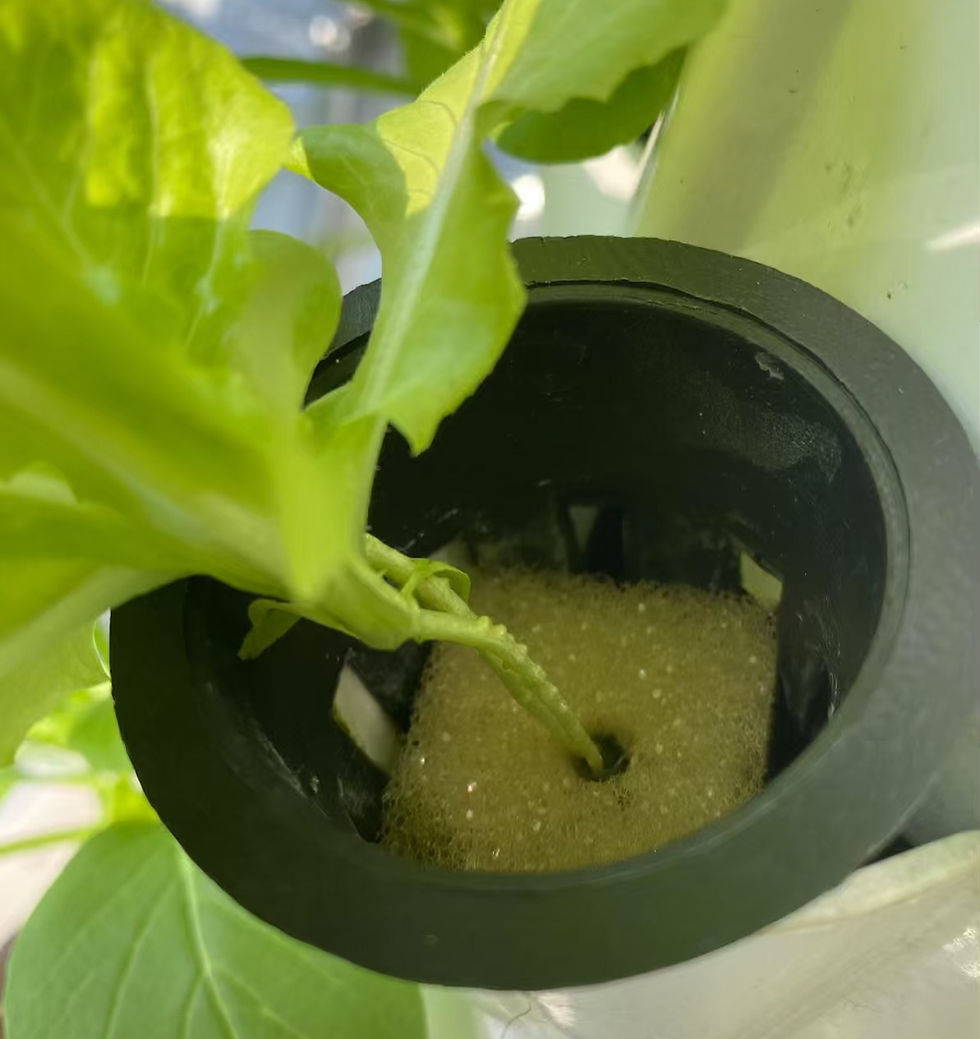How to Choose the Best Net Pots for your Hydroponics System
- Jonathan Valencia
- Jun 30, 2021
- 7 min read
Updated: May 26, 2024

What are Net Pots?
Net pots, in hydroponics, are just like pots in a container soil garden. They hold and support the plant along with the growing medium. They have slits below to allow root growth towards the hydroponic nutrient solution.
Most net pots are reusable, designed with a plastic mesh body that promotes superior circulation of water, nutrients, and oxygen.
Let’s have a look at some of the most important factors to understand about them, below.
Available Net Pot Sizes
The differences in sizes account for the different hydroponic systems available. Most of the time, net cups are already packaged with the hydroponic system. For example, if you purchase a Deep Water Culture system, it will naturally come with a 4-6” net cup.
Does pot size matter in hydroponics?
Yes, pot size does matter in hydroponics. Incorrect pot size can hamper growth, and bigger isn’t always better. There are different pot construction types; and other factors like temperature, space, and most of all the plants themselves to consider.

When choosing a net pot for your hydroponic system you should consider the size of the plant you're growing and the full size and weight of the plant at the time of harvest. Smaller net pots work well for small plants and leafy greens. Larger, heavier plants should be in larger net pots.
Only the base (the root ball) of the plant is supported in a net cup, the roots come out the side of the net cup, and depending on your system they would hang into the water or get misted by the water. The bigger the plant the bigger the size of net pots you’ll need. Lettuce usually uses a 2-3 inch net cup, whereas peppers and squash would use a 3-6 inch net cup.
The Best Net Pots Have More Lip
When searching for the best net pot for your system consider the lip size before purchase. Some net pots will have a well-defined lip, while others don’t have much of a lip at all. This is something I learned during my first year of hydroponic gardening.

I purchased the cheapest net pots I could find, thinking they were all the same. The ones I received didn’t have much lip, so my net pot would fall through the hole after the plant got heavy enough.
Where to find the best prices:
If you're not living in Asia, we have compiled a list of products available on Amazon below.
Do You Use Net Pot Lids?
Anytime light reaches a growing medium moist with nutrients you’re going to get algae growth. Using net pot lids will stop the light from reaching the grow medium and prevent algae growth.

Net pot lids also keep rain and debris from getting into systems that are outside. The one drawback is that tends to not secure well to the net pot, but that doesn’t affect its ability to block the light.
Choosing and Using the Best Hydroponic Pots for Strong and Healthy Plants
To make sure plants are presented with the best opportunity to flourish, there needs to be a delicate juggling act by the grower in three distinct areas. When these are combined, they all help determine pot sizes to be used throughout plants growing cycles.
Space – This will be determined by the type of hydroponic system. Indoor hydroponics systems can have reduced area compared to outdoor systems. Not only would these restrictions be overall floor space, but height is something else to consider.
When you have a height restriction, you will need to use shorter pots, and this equates to shorter plants.
Temperature – This variable catches many growers out when they are first starting. If you are growing indoors and using HID grow lights, or your plants are in an area of direct sunlight, you could find your pots drying out too quickly.
To solve this, you might need to increase your flood time in an ebb and flow system, or you can opt for a drip irrigation system to prevent drying. On the other end of the scale, you have areas that are cooler. Larger pots can remain too moist, and with this comes suffocation and rotting of the roots.
Plants – Your fruit-bearing plants for example will be one of the most distinct areas that dictate pot size. If you are planting seedlings or cuttings, then pot size will be much smaller than when they are healthy growing plants. At this early stage, pots of around 4-inches are sufficient, and once their roots are taking hold, you can transplant up to pots of 6-12 inches to encourage fast root growth.
Can I Reuse Net Pots?
As with many hardy growing mediums like clay pellets and smooth gravel, most net pots can indeed be reused. We reuse our net pots for an average of 5 grow cycles. Before reusing them, however, make sure to properly clean them.
Can I Fill Net pots with Soil to Sow Seeds?
Soil is not suggested for use in net pots. The main reasons that soil isn’t an ideal medium for them are that it tends to become too compacted or waterlogged.
In addition, seeds planted in soil, in net pots, are prone to rotting. Plant roots may also become damaged or break off when you try to remove them.
What Can I Put in Hydroponic Net Pots to Plant Seeds?
Net pots can be filled with just about any sort of growing medium for hydroponic growing systems. That said, a few growing mediums such as sand and peat moss aren’t also very feasible.
The best mediums to fill net pots with include:

Originally used as insulation and also known as mineral wool or stone wool, rock wool was developed in Denmark back in the 1970s for gardening.
It retains moisture well, it retains oxygen well, it never impedes root growth, it is chemically inert, and it comes in a variety of sizes and shapes.
Check the best prices:

Hydroton grow rocks, or expanded clay pellets also referred to as leca clay and clay balls, are one of the most helpful and versatile growing media for any traditional and hydroponic grower.
They’ve gained popularity over the last ten years for their porous shape.
With these pores throughout each ball, the pellets make it easy to support a steady distribution of nutrients, oxygen, and water around the roots of various plants.
Check the best prices:

Grow sponges are soilless growing mediums that ensure seeds have just the right environment for germinating.
They do so by providing the seeds with adequate amounts of oxygen and water and causing them to sprout.
Further, they stimulate rapid growth and healthy root development.
Hydroponic Sponge Growing Mediums provide a great substrate for hydroponic growing because they are porous and can retain water while not too heavy on the plant’s roots.
Check the latest prices:
Why is the right net pot size important when growing hydroponic plants?
A net pot that is too small will not have room for all of the water and nutrient solutions that plants need to grow. This is damaging both to the plant’s root system, and to the seeds, the plant needs to grow.
On the flip side, if you use larger net pots than necessary, this is also damaging to your plants. If you use larger net pots than necessary, your deep water culture and nutrient-rich solution are likely to evaporate before your hydroponic plant can absorb them. This damages the plant’s seed and root structure.
What Can I Use Instead of Net Pots?
Net pots are the best option for hydroponic growing systems, but there are a few alternatives:
Foam cups
Plastic bottles
Plastic cups
Gardening containers
Keep in mind that these options weigh less than net pots and may require additional weight to keep them in place in your growing system. The best way to do so is by adding a growing medium such as pebbles or clay pellets.
In addition, all of the above will require a bit of cutting (to make holes or slits) in order to replicate the functionality of net cups. Also, cotton balls may help to stick your plants to the bottoms of the cups if you don’t add a growing medium for extra weight.
How do I determine what size net pots do I need for hydroponics?
The net pot size that you need depends on the hydroponic plant that you plan to grow in your hydroponic garden.
This guide will give you a helpful rule of thumb to determine what size net pot you need, but to be certain that you have the right one, you need to research the specific species of plant that you are growing in your garden. It is best to ask the retailer for advice when you are purchasing your net pots.

For Hydroponic Lettuce
The best size net pots for hydroponic lettuce and other small leafy hydroponic crops is two inches. Three-inch and four-inch pots may also be useful for species that grow larger than normal.
For Hydroponic Tomatoes
Tomatoes are most typically grown in two-inch net pots. However, larger tomato plants may do better with four-inch net pots. If growing tomatoes in five-gallon bucket systems, six-inch net pots are the best.
For Peppers
Pepper plants that are grown hydroponically require two-inch, four-inch, or six-inch net pots depending on what species you grow and what sort of hydroponic system you use.
For Strawberries
Strawberries do best grown in two-inch to four-inch net pots depending on the variety of berry. In addition, your hydroponics setup could require a specific size pot.
In Conclusion
Choosing a quality net pot upfront while considering other factors will save you time and headaches in the long run. A good net pot will last many years so it is worth it to spend the extra few bucks for the good ones.
Where to find the best prices:
Recommended Reading: Frequently Asked Questions About Hydroponics
Smart Use of Net Pots for Ornamentals


























Comentarios